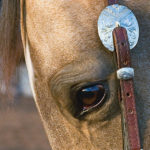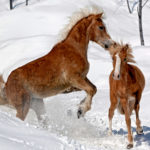 Credit: Thinkstock
Credit: ThinkstockRun-in sheds. To bed or not to bed? There are pros and cons to both sides of the issue, depending on labor, budget and how much use your sheds get.
Event rider and trainer Amie Loring, based at Willow Creek Farm in Southbury, Connecticut, likes bedding her sheds. “When my sheds are bedded, the horses tend to eliminate in the shed rather than the paddock so the paddock stays cleaner and the grass doesn’t get sour. I also find that horses tend to lie down and sleep in the shed when it is bedded, whereas they might be less inclined to sleep in a plain shed or open pasture. For horses that live out, that’s a big factor in my decision to bed.”
Martin Douzant, owner of The Frame Sport Horses in Middleburg, Virginia, prefers not to bed. “My horses are out at night and come in during the day to eat and rest. Choosing not to bed my run-in sheds saves money as well as time and labor, which is key because I do a lot of my own horsekeeping in addition to riding and training. So it makes more sense to just pick out the sheds.”
What kind of bedding is best? Loring prefers a mixture of shavings and sawdust. “It’s absorbent and easy to sift through, so waste is minimal. I have used straw but don’t feel like it’s easy to muck or very absorbent. On the positive side, it’s a very inexpensive way to create a fluffy bed and it tends to smell wonderful when it’s clean.”
Martin Douzant noted that some farms bed their run-in sheds with straw. “In France, it is not uncommon for the farmers to just keep refreshing the top layer of straw in the sheds. The bottom packs down. Then, at a certain point, they just haul all of the straw away and start over. Doing this, though, requires the right equipment.“
Another option is to have a sand or peat floor in the run-in shed. This provides some cushioning and drainage. Virginia Powell, licensed veterinary technician with Fairfield Equine Associates (Newtown, Connecticut), likes these materials for older horses or those with laminitis or joint arthritis. “The natural cushioning is excellent for horses that need it,” she noted. Sand and peat can get dusty.
Before deciding whether to bed your sheds, take note of how much your horses actually use them. If they seldom spend time there, you’re probably better off spending your time and money elsewhere in your operation.





